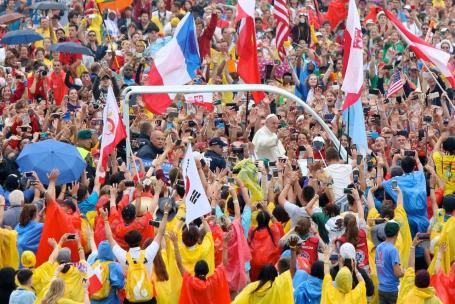Partway through John Burdick’s Blessed Anastacia, the author reports a conversation with Frei David, whom he describes as the “most impassioned theoretician” of the Brazilian Inculturated Mass.1 According to Frei David, the Inculturated Mass was the first step in a process of revolutionary change in the Catholic Church: “And then there is going to be a world revolution…The Brazilian Church and the global Church are going to change radically due to the simple and sincere experiment that is occurring here” (89).
I underlined this passage when I was preparing my notes for this course; it seemed to be as clear a statement as any about one basic intellectual problem at the heart of a course on Global Catholicism: what experiences shape the way Catholics think about “the globe?” Although it is not universally the case, it is true for many Catholics, both in the United States and around the world, that they find it second nature to think about their faith in global terms.
As the Catholics & Cultures initiative has noted, most Catholic young people reach their college-age years having intimate knowledge of only one way of being “cultural” and “Catholic.” One outgrowth of this reality is that many Catholic young people attending university in the United States have gone through their everyday lives assuming that all people feel the same about being part of a “global Catholic Church.” One of the goals of this course is to show how certain experiences shape the way Catholics not simply “think” about the globe, but have hopes for it or worries about it. That is, all Catholics have the same hopes for and fears about the future of the globe.
Frei David’s comments illustrated one possible answer to a version of the question I posed in the title of this post: What comes to mind for urban Brazilian Catholics when they say the globe? For Frei David, the answer seems to be the Inculturated Mass. The answer might also be “revolution,” which is what one student said urban Brazilians of color might hope for the future of the “the globe.” I think my student was on to something. Frei David, as one of the architects of the Inculturated Mass, is clearly hoping for revolution. The Inculturated Mass seems to encapsulate all of his aspirations for the global Catholic Church. His hope is that this is what the global Church will look like in 10, 20, or 50 years.
In reflection statements, a number of students wrote about experiences they had had at global Catholic gatherings. Several students had gone to a recent World Youth Day event, the biannual or triannual gathering for Catholic young people begun during Pope John Paul II’s papacy. Participating in this event clearly shaped their sense of what kind of globe they should hope for. Their aspirations revolved around making new friends and also being of service; they wanted to learn about the ways other people practiced Catholicism, but I also got the sense that, for them, learning and friendship wasn’t enough. Some expressed this desire for more by talking about the difficult family lives or impoverished living conditions of the Catholic young people they met at these conferences. If it is not the Inculturated Mass or World Youth Day, what event or practices brings to mind Catholicism’s global nature for you?
- 1As I mentioned in my first posting about Week 4 of my course on Global Catholicism, the Inculturated Mass was an initiative of liberation activists in the Catholic Church. These activists intentionally designed a Mass that would incorporate practices they identified as “African cultural elements” – music, dance, and iconography.
